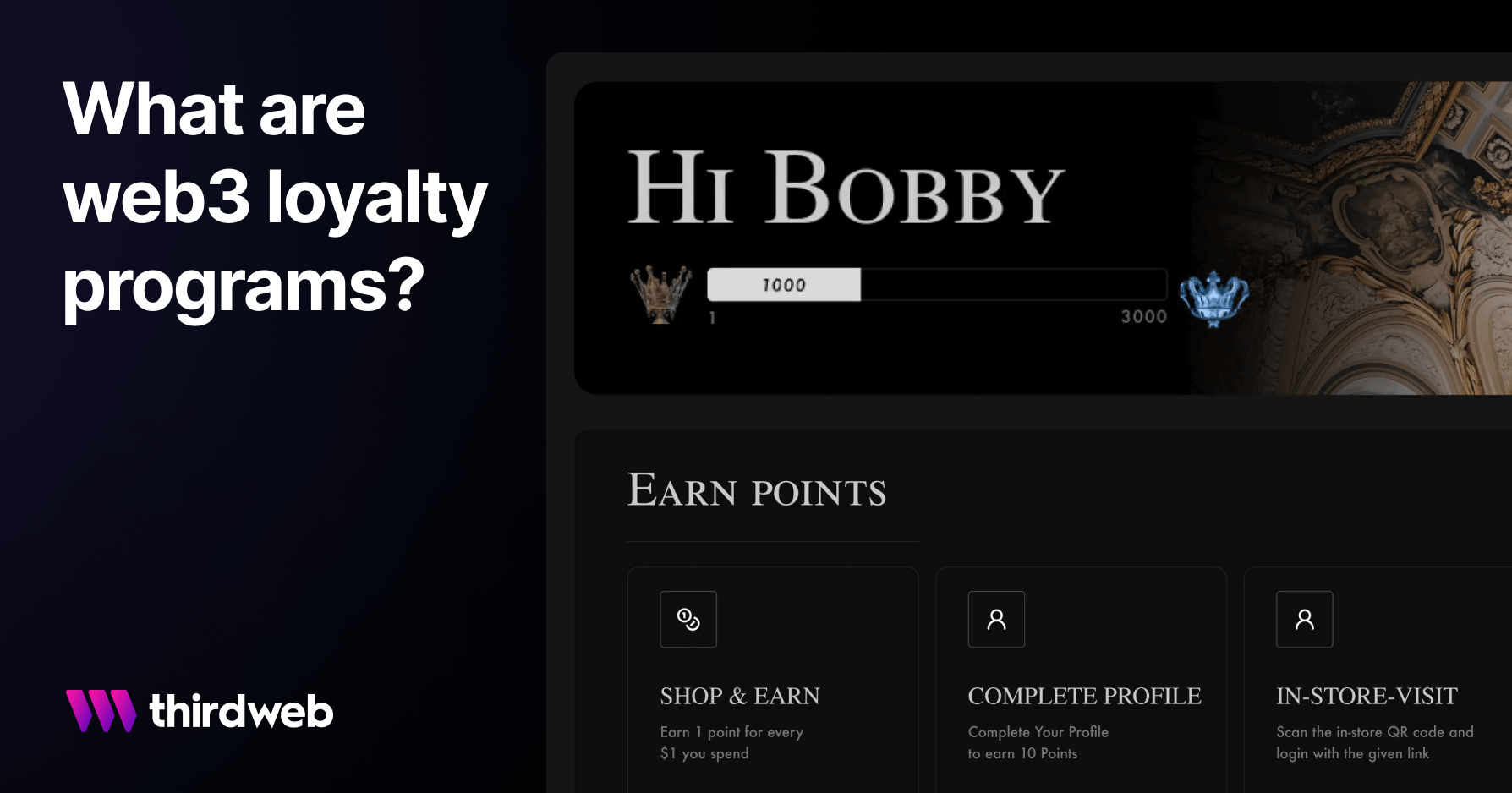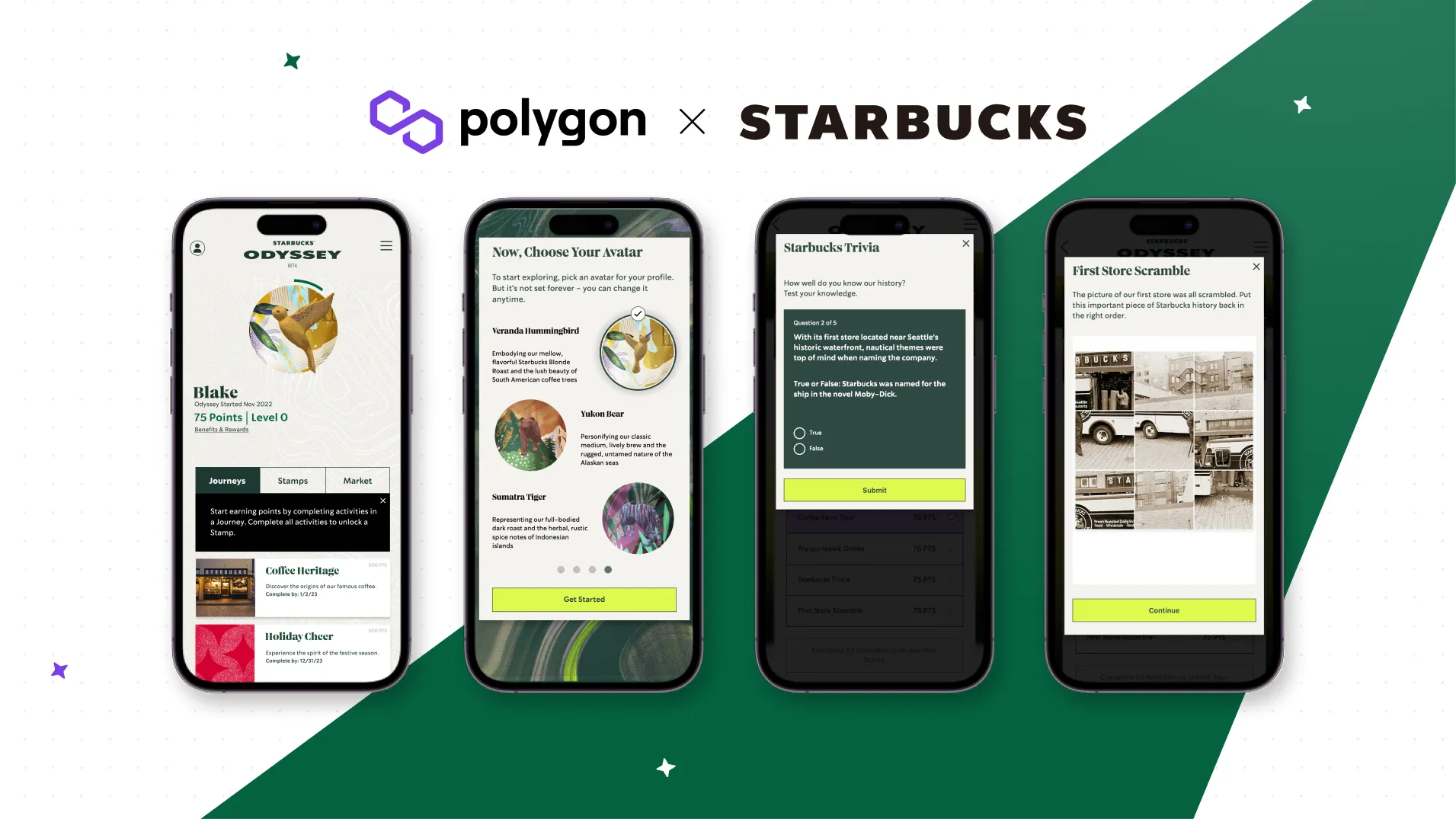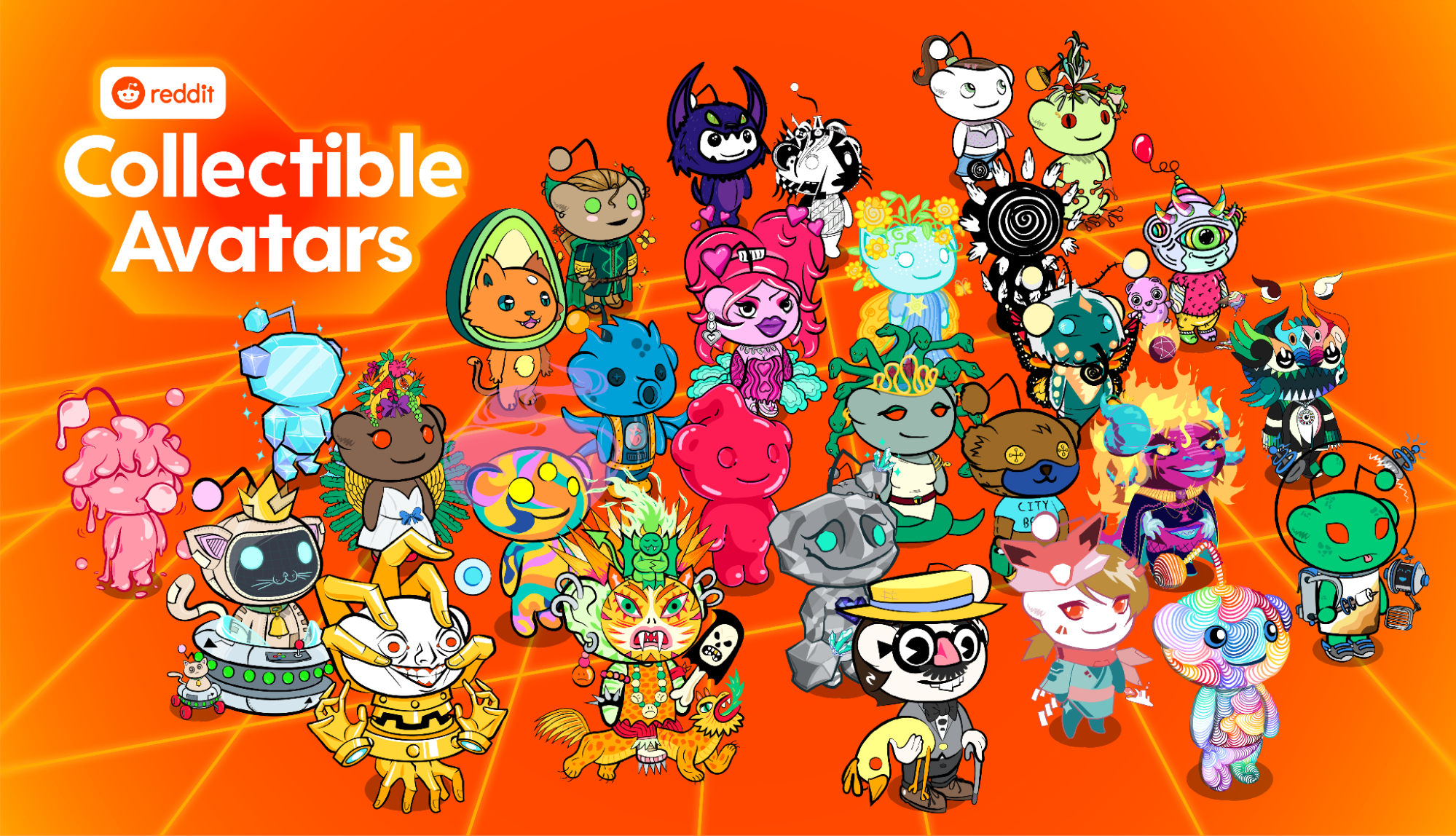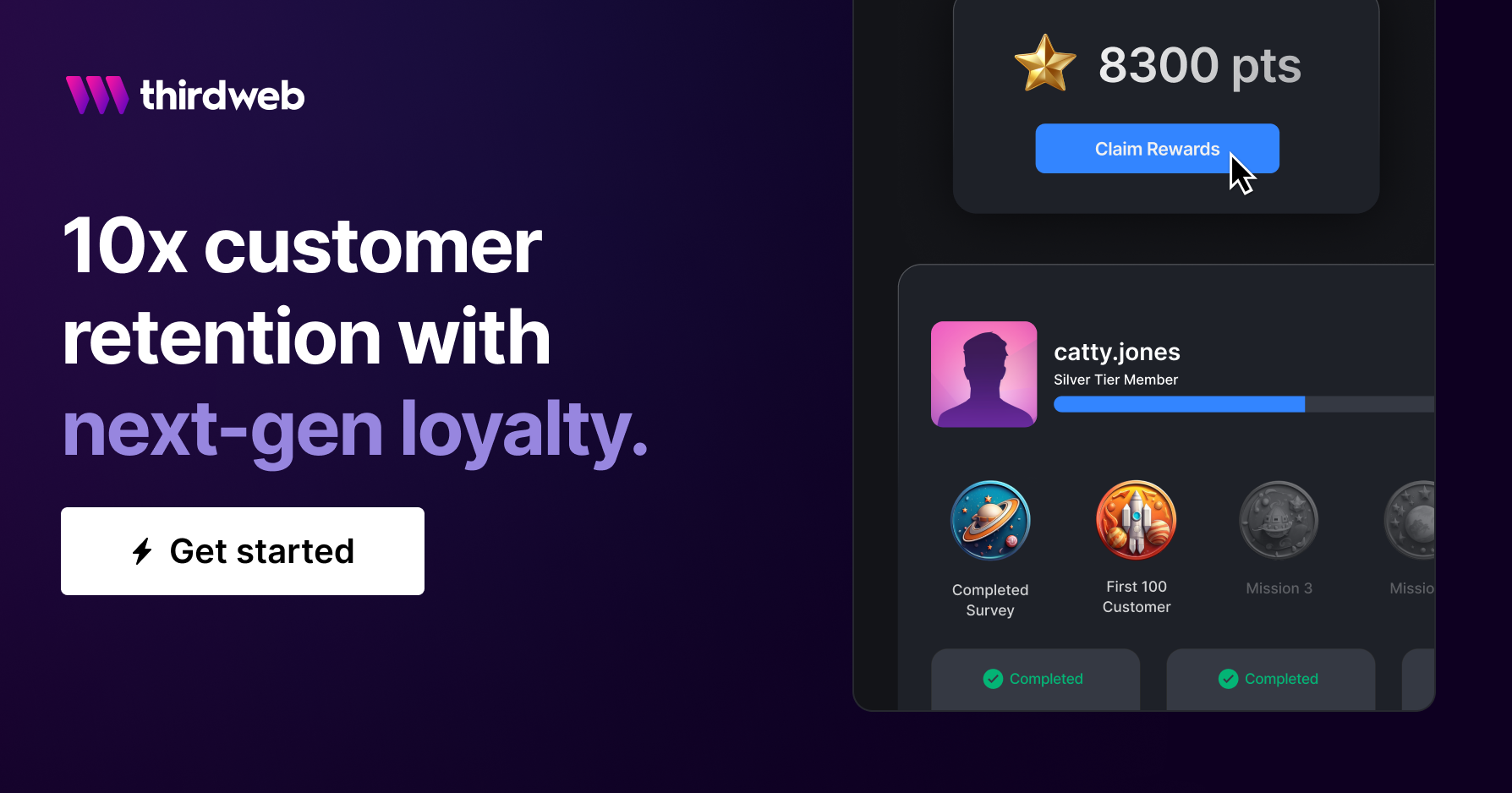What are web3 loyalty programs?
Web3 loyalty programs are turning customers into champions for the world's biggest brands including Starbucks, Nike, & Adidas. Learn more.

9 out of 10 companies have some form of customer loyalty program in place, and for good reason. Loyalty programs transform casual shoppers into brand advocates, reduce customer acquisition costs, and improve their bottomline.
But today’s loyalty programs have a one-size-fits-all approach. Moreover, they operate in centralized and closed ecosystems and their redemption processes are inflexible. This makes the consumers feel disconnected from the very programs intended to retain them. Consequently, almost 85% of loyalty points go unredeemed.
Web3 loyalty programs are a new approach to foster genuine engagement and benefit customers and businesses alike.
But why do loyalty programs need web3? What advantages does it provide? What are some successful examples of brands with web3 loyalty programs? And how do I build one?
In this blog, we break down everything you need to know about web3 loyalty programs and explain how brands can build one for their customers.
What's wrong with today's loyalty programs?
The intent behind loyalty programs — to reward and retain customers — is sound, but their current execution leaves much to be desired. Today’s loyalty programs face many challenges. Here are some of the major ones:
1. Limited Engagement
Despite the average U.S household enrolling in approximately 18 loyalty programs, they actively engage in less than 9 of them. This indicates a wide gap between registration and genuine participation.
2. Restrictive Redemptions
One of the primary frustrations for customers is the limited scope of point redemptions. For instance, certain retail loyalty programs allow points to be used only for specific brands or product categories, which can deter members from engaging further.
3. Devaluation of Points
Brands occasionally restructure their loyalty programs, requiring members to accumulate more points for the same rewards. Brands like Starbucks and Chick-fil-A recently devalued their reward points and faced severe backlash from loyal customers.
What are the advantages of web3 loyalty programs?
Web3 loyalty programs unlock powerful features that are only possible with blockchain-enabled assets — allowing customers to earn loyalty points that they can redeem for dynamic, personalized, digital rewards that they own.
When compared to traditional loyalty programs, they offer a plethora of benefits:
1. Interoperability
One of the key limitations of web2 loyalty programs is the restriction of points to specific brands or ecosystems. Blockchain interoperability breaks this barrier by enabling brands to collaborate with each other and allows rewards from one program to be used for another program.
For instance, loyalty points earned from an airline could be exchanged for hotel stays or eCommerce vouchers.
2. Immutability
The immutable nature of blockchain ensures that loyalty program rules and reward allocations remain consistent and transparent. This builds long-term trust with customers. Brands will no longer be able to arbitrarily devaluate reward points behind closed doors.
3. Personalization
Web3 loyalty programs enable brands to study the on-chain activities of users and provide more personalized experiences. This not only boosts engagement but also makes the customer feel valued and understood on a more individualized level.
Reddit's Collectible Avatars are a great example of using dynamic NFTs for unlockable traits that can be used to personalize their Reddit avatars.
This also allows for an NFT's metadata to change based on how much onchain activity the wallet has, or how many loyalty points have been accumulated by it.
Overall, web3 membership programs allow brands to transform conventional customer engagement into a more immersive and interactive experience.
5 examples of web3 brand loyalty programs
Let’s look at a few brands that have effectively implemented a web3 loyalty program.
1. Starbucks Odyssey

The Starbucks Odyssey is a Web3-powered extension of the Starbucks Rewards program. Members engage in ‘Journeys’, a series of interactive activities ranging from virtual tours of Starbucks coffee farms to trivia about Starbucks heritage.
Upon completing these Journeys, members earn collectible Journey Stamps (NFTs) and Odyssey Points to access exclusive benefits and immersive coffee experiences.
2. Reddit Collectible Avatars

Reddit’s Collectible Avatars are a unique collection of profile picture non-fungible tokens (PFP NFTs) released by Reddit. Each of them represents a customizable iteration of the platform's iconic alien mascot, Snoo.
Currently, these avatars primarily serve as profile pictures but it’s possible that Reddit may add more utilities to the collection in the future.
3. Adidas Metaverse Virtual Gear

Adidas Originals unveiled its first-ever Virtual Gear Collection of NFT digital wearables for Adidas Metaverse. This 16-piece limited edition collection allows users to dress their profile picture avatars, particularly those from renowned NFT collections like Bored Ape Yacht Club and Mutant Ape Yacht Club.
4. Lacoste’s UNDW3

Lacoste UNDW3 is an immersive interactive adventure that allows participants to unlock benefits in exchange for actively engaging with the brand.
As a part of the program, every participant has an UNDW3 NFT card (evolution of the Genesis Pass) which unlocks more features and utilities for the user as they complete more on-chain tasks.
5. EVNTZ & Co:Create

During Harry Styles’ recent concert in Ireland, 5,000 attendees used the Evntz app (powered by Co:Create) to set up their self-custodial wallets that can store blockchain-based rewards. In the future, as these fans engage more with the artist's content, they can earn more loyalty points and unlock more rewards.
How to build a web3 loyalty program
Web3 loyalty programs use smart contracts: self-executing codes with terms directly coded in. This guarantees automated, clear, and secure reward distribution.
Once the smart contracts are written, they are deployed to the blockchain along with a frontend interface, and wallets like Metamask are integrated so users can sign a transaction.
Many programs also integrate marketplaces, enabling users to buy, sell, or trade their loyalty points and rewards.
thirdweb offers all the necessary tools to integrate these features into your loyalty programs and activate new customer experiences and revenue streams. Here are some advantages of using thirdweb to build your loyalty program:
- Expand Your Reach: Collaborate with other brands and let customers earn and use loyalty points across a range of partners, enhancing engagement.
- Boost customer lifetime value: Build communities and transform customers into brand champions by offering customers digital collectibles.
- Unlock new revenue streams: Generate consistent income from membership subscriptions, sell digital assets directly from your storefront, and earn royalty fees from the trading of loyalty points.
Get started with thirdweb's Loyalty solutions for free:

The future of loyalty programs
Web3 loyalty programs, backed by blockchain, are setting a new gold standard in customer engagement and brand loyalty.
As they continue to evolve, they will redefine customer-brand relationships and make loyalty more personalized and rewarding.
We hope this blog helped you better understand how web3 loyalty programs work and their advantages.
If you have any questions, join 42,000+ other builders in our Discord community or reach out to the team directly for more info on how to get started with building your web3 loyalty program.
